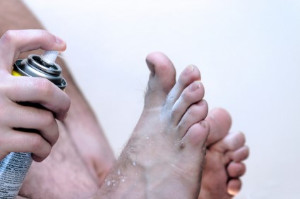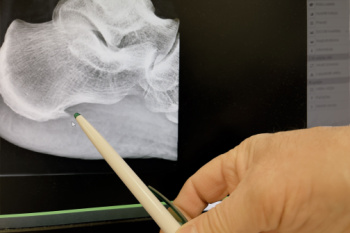Items filtered by date: May 2024
Care Needed by Those Who Work on Their Feet

Working on your feet for prolonged periods can negatively impact foot health and overall well-being. Constant standing puts pressure on the feet, leading to issues such as plantar fasciitis, bunions, heel spurs, and varicose veins. Additionally, prolonged standing can cause leg swelling, muscle fatigue, and lower back pain, contributing to long-term health problems like joint and cardiovascular issues. Symptoms of these problems include persistent foot pain, swelling, stiffness, and discomfort in the legs and lower back. If left unaddressed, these conditions can worsen, leading to decreased mobility and quality of life. To mitigate these effects, it is important to wear supportive footwear, take regular breaks to sit and elevate your feet, and perform stretching exercises to improve circulation and flexibility. Using anti-fatigue mats can also reduce the strain on your feet and legs. If you have a job that requires prolonged standing, it is suggested that you consult a chiropodist for tailored solutions to manage pain and prevent further complications.
If you stand all day, you may be at an increased risk of developing various foot conditions. If you are experiencing foot pain of any kind, please consult with Emily Yu, B.Sc from Uptown Foot Care Clinic. Our specialist will assess your condition and provide you with quality foot and ankle treatment.
What Foot Problems Are Caused by Standing?
Standing all day at work may increase your risk of developing foot or ankle problems.
Some common foot conditions that may arise from spending all day on your feet include:
Foot pain
Blisters
Corns and calluses
Arthritis
Flat feet
Bunions
Sprains
Athlete’s foot
Prevention
If you stand for prolonged periods of time for work, taking preventative measures to preserve the health of your feet is strongly recommended.
Measures you can implement to help prevent foot problems include:
Wearing shoes that are comfortable and fit well - these shoes should be made of breathable materials and provide you with arch support and cushioning. It is best to avoid shoes that have heels or narrow toe boxes.
Taking breaks to rest, walk, and stretch your feet throughout the day
Maintaining good foot hygiene - wash and dry your feet thoroughly every day
If you have any questions, please feel free to contact our office located in . We offer the newest diagnostic and treatment technologies for all your foot care needs.
Causes and Treatment of Athlete’s Foot

Athlete's foot is a fungal infection that typically appears as a rash between the toes. Symptoms include itching, redness, cracking, or blistering. Athlete’s foot warrants prompt attention since it can be easily transmitted to other areas of your body. This infection primarily targets the skin between the toes or the soles of the feet. Scratching the affected area and touching other parts of the body can contribute to its spread. This can also lead to complications like bacterial infections or cellulitis. Athlete's foot is fueled by fungi that thrive in warm, moist environments, making individuals susceptible if they neglect foot hygiene or wear non-breathable footwear. Walking barefoot in communal areas, such as locker rooms or swimming pools, increases the risk. Treatment of athlete’s foot infections typically includes antifungal medications. However, should symptoms persist beyond two weeks, or worsen, or if you have other health concerns such as diabetes, it is suggested that you make an appointment with a chiropodist for more advanced care.
Athlete’s foot can be uncomfortable and unsightly. To learn more about preventing and treating this condition, please consult with Emily Yu, B.Sc from Uptown Foot Care Clinic. Our specialist will assess your condition and provide you with quality foot and ankle treatment.
What Is Athlete’s Foot?
Athlete’s foot refers to an infection of the skin on the feet that is caused by a fungus. This fungus is contagious and thrives in warm and moist environments. It is often spread in common areas such as public pools, locker rooms, and showers. It can also spread when sharing personal items, like shoes or towels, with an infected person.
Symptoms
The symptoms of athlete’s foot may include:
Itching, stinging, or burning of the skin on the feet
Cracking or peeling skin, especially between the toes and on the soles of the feet
Scaly, red rash on the foot
Blisters
Foul odor
Treatment
Treatment for athlete’s foot typically involves using over-the-counter topical antifungal medications on the feet. When over-the-counter options are ineffective, you may need to take prescription oral medications or topical antifungal drugs, or a combination of both.
Prevention
Preventing athlete’s foot places an emphasis on good foot hygiene practices.
You can prevent athlete’s foot by:
Washing and drying your feet thoroughly every day
Wearing shoes when walking in public areas
Not sharing personal items, like shoes or socks, with others
Wearing shoes and socks made out of breathable materials
If you have any questions, please feel free to contact our office located in . We offer the newest diagnostic and treatment technologies for all your foot care needs.
Definition and Causes of Heel Spurs

Heel spurs refer to bony protrusions that develop on the underside of the heel bone. These spurs often result from calcium deposits forming over time, typically due to repetitive strain or stress on the foot ligaments and muscles. While many individuals with heel spurs may not experience any symptoms, others may encounter pain and discomfort, particularly when standing or walking. Contributing factors to the formation of heel spurs include wearing ill-fitting shoes, engaging in activities that place excessive pressure on the feet, such as running or jumping, and certain medical conditions like plantar fasciitis or arthritis. Overweight or obese individuals are also at a higher risk of developing heel spurs due to increased strain on the feet. Understanding the definition and causes of heel spurs empowers individuals to take proactive measures to alleviate discomfort. Heel spurs can be painful, and if you have this foot condition, it is suggested that you consult a chiropodist who can offer you effective treatment options.
Heel spurs are bony outgrowths from calcium deposits. They occur at the back of the heel bone or underneath the heel bone and usually form in response to chronic irritation of the Achilles tendon or plantar fascia. They are often asymptomatic, but if you are suffering from heel pain, please consult with Emily Yu, B.Sc from Uptown Foot Care Clinic. Our specialist can help you maintain the health of your lower limbs and your mobility.
Symptoms of Heel Spurs
Tenderness
Heel pain
Pain when walking
No symptoms
Diagnosis
Since heel spurs are often asymptomatic, they are usually only diagnosed when they are found on the heels incidentally during an X-ray taken for another reason. Nevertheless, if you have heel pain, and particularly if you have plantar fasciitis or Achilles tendonitis, it may be worth it to see if you have heel spurs too.
Treatment
Unless they are causing symptoms, heel spurs typically don’t require any treatment. When they are symptomatic, treatments are typically conservative. They may include resting and icing the affected foot, taking anti-inflammatory medications, and wearing orthotics or supportive footwear, especially while exercising.
If you have any questions, please feel free to contact our office located in . We offer the newest diagnostic and treatment technologies for all your foot care needs.
High Heels and Foot Pain

Wearing high heels may make you feel taller and more beautiful, but they can also wreak havoc on your foot health. The elevated position of the foot in high heels puts tremendous pressure on the forefoot. This can lead to issues like bunions, hammertoes, corns, and calluses. Long-term wear of high heels can result in structural abnormalities and may even require surgical intervention. High heels can also strain the Achilles tendon, leading to Achilles tendonitis, and can cause inflammation of the plantar fascia, known as plantar fasciitis. Additionally, the altered posture from wearing high heels can contribute to knee and back pain, which may alter your posture, gait, and balance. Conditions like Haglund’s deformity, a bump on the back of the heel, and Morton’s neuroma, which is metatarsal nerve pain, are also associated with prolonged high heel use. Despite the allure of high heels, it is important to prioritize foot health. To manage pain caused by wearing high heels, it is suggested that you consult a chiropodist for treatment options.
High heels have been in style for centuries, but unfortunately, they have also been damaging feet for centuries. If you would like to learn more about how high heels can hurt your feet, please consult with Emily Yu, B.Sc from Uptown Foot Care Clinic. Our specialist can help you maintain the health of your lower limbs and your mobility.
High heels can cause a variety of problems, including:
Foot and ankle pain
Foot and ankle injuries
Toe pain and deformities
Gait abnormalities
Achilles tendonitis
Changes in posture
Difficulty balancing
Leg, hip, and back pain
If you are reluctant to abandon your high heels, you can still wear them, but should take measures to minimize damage to your feet:
Wear shoes with heels no higher than 2 inches
Choose properly fitted shoes
Choose shoes with a wide toe box
Wear high heels infrequently
When wearing high heels, take them off periodically to stretch and relax your feet
If you have any questions, please feel free to contact our office located in . We offer the newest diagnostic and treatment technologies for all your foot care needs.

